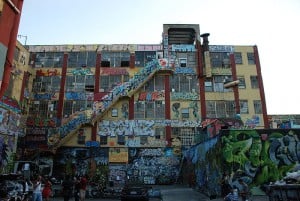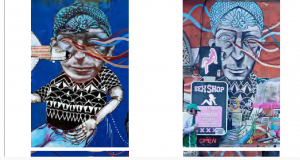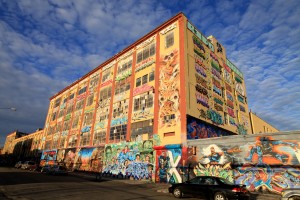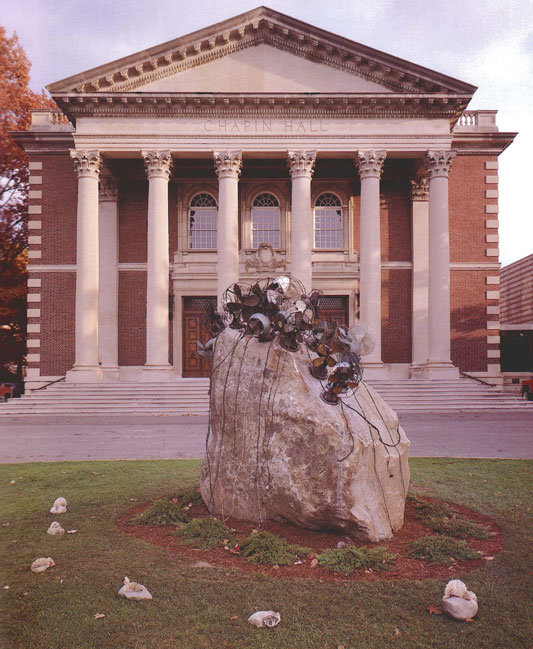Detroit police have issued a warrant for well-known artist Shepard Fairey in connection with his recent visit to the city, on suspicion of vandalism. While Fairey was apparently in Detroit to paint a commissioned mural at One Campus Martius, he told the Detroit Free Press, “I still do stuff on the street without permission. I'll be doing stuff on the street when I'm in Detroit.” According to the Free Press:
Shepard Fairey Wanted on Vandalism Charge for Street Art in Detroit—Will This be the VARA Test Case?
Topics: Richard Prince, Jeff Koons, Patrick Cariou, Moral Rights, Andre the Giant, Graffiti Art, Visual Artists Rights Act of 1990, Barack Obama, One Campus Martius, Banksy Does New York, VARA, Banksy, Shepard Fairey, appropriation copyright, Copyright, 5Pointz, Hope, Detroit Free Press, Associated Press, Fair Use
5Pointz Property Owner Sued Again Over Whitewashing of Graffiti—Measure of Damages Bears Watching
Several street artists have sued the property owners of the building in Queens that became known as “5Pointz”—a “Mecca” of graffiti and street art. This is the second such lawsuit, after another group of artists failed to obtain a preliminary injunction in November, 2013, and the owners whitewashed nearly all of the painting on the buildings. The new lawsuit seeks damages related to the whitewashing itself, alleging that it was done hastily and secretly without giving the artists sufficient time either to remove or document their work. It relies on the Visual Artists Rights Act of 1990 (VARA), the lone moral rights provision of the Copyright Act.
Topics: HBO, Copyright Act, Ishmael, Moral Rights, Richard Miller, Cady Nolan, Rodney Rodriguez, FCEE, Christoph Büchel’s, Graffiti Art, Visual Artists Rights Act, Patch Whiskey, Kai Niederhausen Semor, Kenji Takabayashi, recognized stature, Banksy Does New York, Jimmy C, VARA, Jerry Wolkoff, Bienbenido Guerra, Luis Gomez, MassMoCA, Banksy, TOOFLY, 17 U.S.C. § 106A, Carlo Nieva, Copyright, 5Pointz, PANIC, James Cochran, Sotheby's, Maria Castillo
Graffiti, Vandalism, and Public Expression: Public Art and its Uneasy Relationship with the Law
Recurring events involving public art have underscored the tension between that expression and the law. Banksy’s “residence” in New York last fall broached this subject, but this summer’s Brooklyn Bridge flag incident, and several new lawsuits asserting copyright in graffiti will test the bounds of what the law protects and what it permits. As Banksy says in one of his murals, "graffiti is a crime."
Topics: Burrow-Giles Lithographic Co. v. Sarony, Ahol Sniffs Glue, David Anasagasti, Steel, City as Canvas, Moral Rights, Argentina, Public Art, Graffiti Art, Philippa Loengard, Visual Artists Rights Act of 1990, Leonardo’s Last Supper, Columbia Law School’s Kernochan Center for Law Med, Chicago, Museum of the City of New York, VARA, Public Expression, Michael Bloomberg, American Eagle, Terry Gilliam, Banksy, 17 U.S.C. § 106A, Copyright, Buenos Aires, 5Pointz, Revok, Roberto Cavalli, vandalism, Reyes, Graffiti, The Atlantic, New York
5Pointz Not of "Recognized Stature" Under the Visual Artists Rights Act? Court Takes the Narrow View and Paintings are Whitewashed
Amidst all the coverage over famed graffiti artist Banksy’s recent "residence" in New York and questions about how artistic license would fare against trespassing and graffiti laws (short answer: poorly), another graffiti case in New York this month has explored the reach of the Visual Artists Rights Act of 1990 (VARA). Ultimately, the law did not suffice to prevent the owner of the so-called "graffiti Mecca" from proceeding with its intended use of the property (and obliteration of the graffiti).
Topics: Carter v. Helmsley-Spear, Copyright Act, Inc., Graffiti Art, Visual Artists Rights Act, recognized stature, VARA, Jerry Wolkoff, Banksy, 17 U.S.C. § 106A, Erin Thompson, Copyright, 5Pointz, Litigation
The Center for Art Law has a thought-provoking piece about the intersection of property rights and Banksy’s “residence” in New York right now. Mayor Bloomberg went on record too as saying he considered graffiti, and implicitly the works themselves, “a sign of decay.” It’s hard to see a court making an exception in New York City for graffiti, no matter what the art world says.
Topics: David Hammons, Rock Fan, Public Art, Graffiti Art, Williams College, Michael Bloomberg, Banksy, Chapin Hall, Eugene Johnson, vandalism, Center for Art Law






